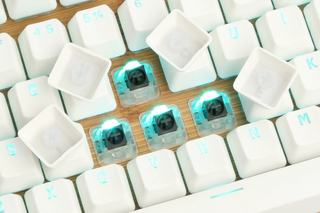What Are Hall Effect Keyboard Switches, And How Do They Work? (Video)

Hall Effect switches are a completely different beast from most of the mechanical keyboard switches that are ubiquitous on the market. Some early keyboards offered them, but due primarily to their high cost of manufacturing, their popularity evaporated. Now, though, they cost significantly less (and are easier) to make, and as we wrote earlier, they may be re-emerging thanks to a grassroots effort.
But...what are they, exactly, and how do they work? The video below explains the science of Hall Effect switches and the advantage they offer over most types of mechanical keyboard switches.
In a nutshell, whereas most mechanical keyboard switches (from the likes of Cherry and Kailh) require two physical contact points for operation (which introduces friction), Hall Effect switches use magnetism (with a conical spring for physical resistance) to engage a key press. This inherently eliminates key chatter and debounce, and it makes the key presses feel incredibly smooth by comparison.
Further, the lifetime of Hall Effect switches is beyond absurd; whereas the likes of Cherry and Kailh (and others) offer life spans in the tens of millions of clicks, Hall Effect switches will endure for tens of billions of clicks.
Now that the cost of making the switches and installing them on keyboards has become feasible, it’s possible that we’ll see more keyboards sporting Hall Effect switches in the not-too-distant future.
Stay On the Cutting Edge: Get the Tom's Hardware Newsletter
Join the experts who read Tom's Hardware for the inside track on enthusiast PC tech news — and have for over 25 years. We'll send breaking news and in-depth reviews of CPUs, GPUs, AI, maker hardware and more straight to your inbox.

Portable AI supercomputer comes as a carry-on suitcase with wheels — four GPUs, 246TB of storage, and a 2,500W integrated power supply

Asus quotes ridiculous $2,750 fee to replace chipped GPU power connector— docs back up claims of egregious repair pricing for $2,000 RTX 4090 GPU

Vendor releases an Intel motherboard for Anime fans — iCraft B760M Cross comes decked out with pastel colors
-
CKKwan I think a LED switch will be better, cheaper and last even longer.Reply
Besides, your keyboard needs to have the 'clicking' feel -
cats_Paw The click effect is good for me in terms of feedback.Reply
Its not that I like the click per se, but I need the feedback in some games like starcraft broodwar. -
Bibbily bong Physical switch or hall effect magnetic magic, I don't care, but I do know I like my keys clicky. Thus, a fan of cherry mx blue. I've used other switches and whilst I can type with linear press (Brown, red) I just don't feel as comfortable. I do a lot of writing, and I play a lot of games. I like the clicky keysReply -
nikolajj Reply18939857 said:Physical switch or hall effect magnetic magic, I don't care, but I do know I like my keys clicky. Thus, a fan of cherry mx blue. I've used other switches and whilst I can type with linear press (Brown, red) I just don't feel as comfortable. I do a lot of writing, and I play a lot of games. I like the clicky keys
Brown is now linear, black is :)
Brown has about the same bump as blue, but without the noise. This is what I prefer. -
rardeva I would love to try this, i don't care about the clicky, I need something more sensitive with less effort, and without the noise, because I don't need it.Reply -
RedJaron Haven't talked about Hall effect and debounce since my paintball days. The cool thing about these actuations is you can actually use a second magnet in the key for the resistance. Two ways to do that: either pushing two like magnets together or pulling two opposite magnets apart. The first method is similar to a spring ( resistance increases the farther you push ), the other reverses it. Also since magnetism follows the inverse square law, the resistive force changes drastically after a few millimeters, while a spring is almost linear.Reply
Ahhh, I still remember the magnetic trigger on my old E-Mag. It used the attractive method with two magnets holding the trigger forward. I used some extra magnets to stiffen it up against accidental firing. Trigger broke at about 2 lbs. Once it broke, the resistance fell to almost zero. Smoothest trigger I ever had. I'd like to see what a keyboard with the same actuation would feel like.
But I too prefer a little tactile feedback on my keystrokes, so I'd like to see some kind of "bump" incorporated into these. -
bit_user Reply
When the primary rationale, in the article, was for longevity, I was wondering why not just use capacitive? But if the magnet is being used to provide physical resistance, that would be one reason.18947670 said:Haven't talked about Hall effect and debounce since my paintball days. The cool thing about these actuations is you can actually use a second magnet in the key for the resistance.
Although, that calls into question the reliability figures... don't magnets weaken, with time & use? -
RedJaron Reply
Um, yeah, if you go above the Curie temperature for the material. But at room temperature, we're talking hundreds, if not thousands, of years to see any change.18989771 said:Although, that calls into question the reliability figures... don't magnets weaken, with time & use?
Most Popular




